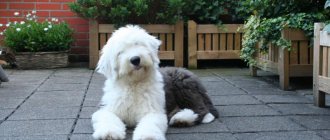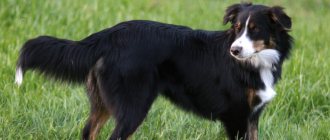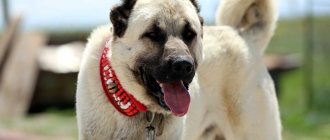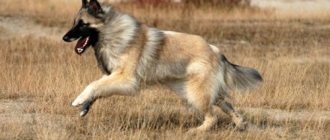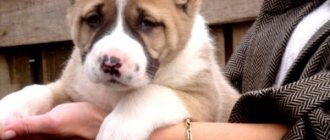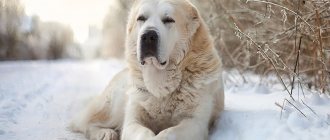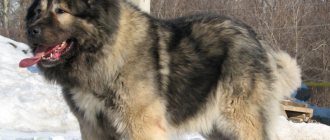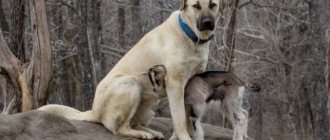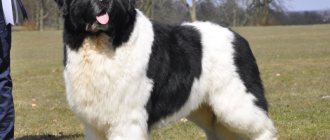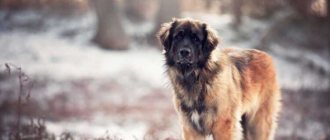Published: 1 year ago ⭐️⭐️⭐️⭐️⭐️
The most famous breed in the countries of Central Asia is the Asian Shepherd, which has several varieties and names. In the same habitat, under the influence of many factors, lesser-known species gained the right to exist.
Due to climatic conditions and the lifestyle of the population, dogs play the role of shepherds or hunters in Central Asia. Some indigenous breeds are still not recognized by world associations and are on the verge of extinction, while others, on the contrary, are gaining popularity outside Central Asia.
Sagi Dahmardak
Sagi Dakhmardak is a subspecies of Central Asians, a relative of the Uzbek one, only bred in Tajikistan. This breed is called “Asians” by non-indigenous residents of the republic. The breed received its name from the ancient Tajik language that Sagi Dakhmardak means “man with ten powers.”
These Asians are the best shepherds in the world, loyal friends. In the mountainous regions of the republic it is not even customary to tie them. Sagas are free dogs and perform their duty with dignity without unnecessary commands.
Going far into the mountains in search of better pastures, the dog always follows its owner, understanding his commands perfectly: to turn around or bring up the herd, to return to bring the lagging lamb. With the herd settled, the saga goes to bed; he can sleep the whole sunny day.
If there is a shadow, it will lie there, but if there is no shadow, the Asian will instinctively dig a large hole to get to the wet ground and lie down on the side. This breed is sometimes jokingly called “earth dogs” in Tajikistan.
It's still not worth teasing them. Despite its large size and weight, the sagi runs quickly. The dog is even able to catch up and kill a wolf that threatens the herd with its appearance on the horizon. As a result, these shepherd dogs are known throughout the world as “wolfhounds.” Sagas Dakhmardak are fearless, obedient, loyal, they are the pride of Tajikistan!
How much does a Central Asian Shepherd cost?
The Alabai puppy is evaluated depending on its suitability for the breed. There are three classes of “suitability” of dogs:
- Pet. The individual will not produce purebred offspring, but will be a good guard. The average price is 15,000 rubles.
- Breed. Typical purebred CAO. Estimated at 15,000 – 20,000 rubles.
- Show. Unique purebred Alabai. For such a puppy, breeders will ask for at least 30,000 rubles.
When purchasing a dog, do not forget to check that the documentation is correct.
Childbirth
Puppies can come out with both their heads and tails, but always with the amniotic sac instead. It must be remembered that the number of placenta during childbirth should always be equal to the number of puppies born. The first newborns come out quickly, and then the interval may increase - this is also worth remembering.
Your first labor can be especially difficult, so it's important that you don't miss the start. If the dog is a “firstborn”, it may not be able to rupture the amniotic sac itself, so you will have to do it - rupture it, rub the puppy. If the mother herself has chewed the umbilical cord, then bring it to the nipples; if not, then do it yourself.
The birth process can last differently: from 2.5 hours to 16. After birth, all puppies must find and suck milk at their mother's breast.
How many puppies does it give birth to?
Usually, the Alabai gives birth to many puppies . On average, this is 6-10 puppies.
But here everything is individual, the number of kids can be much larger or smaller. The younger the bitch, the larger the litter she will produce.
Offspring in winter
It happens that a dog gives birth during the winter period . If the dog is in the yard, it still needs to be placed in a warm room to protect the mother and offspring from hypothermia.
The dog should not be in the cold or draft, and the recommended temperature is +26-+30 degrees.
Estrus
For the first time, bitches of the Alabai breed “heat” at the age of 7–10 months, and the first heat may be shorter and less pronounced than all subsequent ones. It usually lasts 21–24 days, followed by a period of inactivity lasting 6 to 8 months.
About a month before, the bitch becomes disobedient, can snap, loses her appetite, and sometimes even marks her territory.
Externally, estrus is manifested by swelling and enlargement of the external genitalia (loop) and discharge: initially bloody, and later lighter.
In the first days, the bitch does not allow male dogs to approach her; she growls and snaps if they try to approach her. But by the 8th–9th day of estrus, she begins to accept their advances and, if control is weakened, she can run away and mate on the side. By the fifteenth day the bitch becomes calmer. At this time, her ability to fertilize decreases, but she can still become pregnant, so constant monitoring of the dog is necessary.
ATTENTION! Estrus, especially the first one, is always stressful for the animal. You cannot scold and punish him unnecessarily. Also at this time it is necessary to protect the dog from hypothermia and ensure that its diet is balanced.
Alabaev mating
It is recommended to untie a bitch of this breed on the third heat, but mating is best done on days 9–14.
In the very first days after the bitch has “flowed”, you should call the owner of the selected male and agree with him on the time of mating. It is necessary to discuss in advance all the conditions and how payment will be made. Usually, mating is either immediately paid for on the spot, or the owner of the male takes one or two puppies as payment for mating.
In this case, you should remember:
- Only healthy dogs with a balanced temperament and a stable psyche can be bred.
- Before mating, it is necessary to show the bitch to a veterinarian.
- 3-4 weeks before estrus, it is necessary to give the bitch anthelmintic, since later, during pregnancy and nursing, this cannot be done.
- For the first mating, you should select an experienced male.
- It is advisable to invite an instructor who will tell you what to do if any difficulties arise.
- As a rule, dogs are bred in the male territory: there he will behave more confidently.
- It is better to knit dogs in the morning, without feeding them, but giving them a good walk.
- It is advisable to have only three people present: the owner of the bitch, the owner of the dog and the instructor; strangers will only interfere.
- Mating should be carried out in a calm environment.
There are two ways of knitting: freestyle and manual.
In free mode, the dogs are left together for a while; in manual mode, the dogs are helped. The second method should be used only if the animals for some reason cannot breed on their own. Both dogs should have collars, and if the “bride” is too obstinate, then she should be muzzled.
The owner of the bitch needs to hold her by the collar with one hand and under the belly with the other. A male dog usually does not need help, but sometimes, if he cannot reach the bitch’s loop, he has to be seated.
During mating, you should not shout at the dogs and, of course, under no circumstances should you force them apart. Owners should reassure their pets if they show indecisiveness, and, conversely, calm them down if they become overexcited.
One or two days after the main one, it is recommended to carry out a control mating, especially if there is no confidence that the first one was successful.
Heritage of the nation - Buryat-Mongolian wolfhound
The true origin of wolfhounds is Central Asia, but the breed is widespread in Uzbekistan and Buryatia.
In the distant past, they were used as guards at Buddhist monasteries. Wolfhounds have proven themselves to be excellent hunters, reliable bodyguards, and good bloodhounds. Take the Attention Test! Find 10 differences! (click right here!)
Find the answer Are you bothered by some problem or question? Enter “Breed” or “Name of the problem” into the form, press Enter and you will find out everything about the issue that interests you.
Wolfhounds are unpretentious in keeping, quickly get used to new living conditions, have good health, and developed intuition. They are distinguished by true fidelity, devotion, and love for children.
Other names are known: Tibet or Tabet, Khotosho, Bankhar, Mongol.
Where to buy a purebred dog?
If you decide to buy a puppy, then you will certainly have a question about where to buy a purebred Alabai. You can buy an animal at a bird market, but you will not have evidence that it is an Asian Shepherd. The nursery will be ready to give you a puppy for 15-40 thousand rubles. Naturally, the breed of an animal purchased at a special institution will be documented. In addition, the puppy will have the right to participate in various competitions and exhibitions.
What factors does the life expectancy of an alabai depend on?
The lifespan of a Central Asian Shepherd depends on a number of factors. The place in which the dog is kept has a big influence. Alabai requires cleanliness and warmth. Many people mistakenly believe that Central Asians are supposed to sleep in the snow, and they don’t freeze.
Important! Experienced dog breeders advise paying attention to your pet’s diet. A balanced diet is the key to a long life for a dog.
It is necessary to carefully care for your pet's fur.
A large dog needs a large, spacious kennel
Where is the best place to keep a dog?
Alabai feels good in an insulated booth in the yard. Aviary housing involves the free movement of the dog around the site. Breeders do not recommend putting the dog on a chain; as a last resort, letting it roam around the area at night
It is important to fence the yard and not allow the dog to “walk on its own”, especially in crowded places
Alabai will not refuse to enter the house, and if the owner allows it, he will happily sleep on the carpet.
Optimal diet
The Central Asian Shepherd's menu should include meat, cereals, and vegetables. Breeders recommend cooking buckwheat, oatmeal, and rice in meat broth. You should give your dog beef, chicken and turkey. Alabai are not allowed to eat pork in any form. Several times a week, an adult dog needs cottage cheese and eggs. The pet must receive calcium. Alabai eat carrots, cucumbers, and peppers with pleasure. You can give your dog zucchini and lettuce leaves.
Potatoes and cabbage should not be introduced into your pet’s diet. Potatoes contain a lot of starch, which negatively affects the digestive system. Cabbage provokes increased gas formation in the dog, causing him discomfort.
Important! The veterinarian selects a suitable vitamin complex, which is given to the animal for a month, and then take a break for two to three months. You can feed Alabai with special food that contains all the necessary microelements
Manufacturers indicate on the packaging the recommended amount of food per animal per day, based on body weight
You can feed Alabai with special food that contains all the necessary microelements. Manufacturers indicate on the packaging the recommended amount of food per animal per day, based on body weight.
Hygiene procedures
The Central Asian Shepherd needs constant care. You should brush your dog regularly and avoid the formation of mats. It is necessary to trim the animal’s claws in a timely manner if they do not become worn down during long walks.
Alabais love water, so swimming gives them pleasure. For hygiene procedures, it is better to use a special shampoo for dogs. Human hygiene products are not suitable for dogs.
You should not forget to clean your pet's ears and teeth. The eyes are treated with special drops, which can be purchased at a veterinary office.
Aviary and booth
Dog lovers are opposed to kennel keeping, as it limits the freedom of the animal. However, Alabai can live peacefully in an enclosure, provided that it is equipped with a warm booth and the area of the enclosure allows for an active lifestyle. It is better to sheathe the booth with special insulation. You need to choose the middle between expensive and cheap material and make your dog a cozy home.
The kennel for the Alabai must be insulated
Aviaries are often equipped for safety purposes in homes where there are small children. You can make a kennel and fencing with your own hands.
Walk
Central Asians need activity. Daily walks take at least three hours. Dog handlers advise walking your dog three times a day.
In cases where the animal lives in a private house and has constant access to the street, you can walk it long distances once a day.
Important! When dog handlers are asked how long Alabai live, they unanimously answer that walks affect the dog’s life expectancy
Daily walks with alabai are necessary for health
Vaccinations
The dog must be vaccinated as prescribed by the veterinarian. Your puppy should be vaccinated against the following diseases before he is one year old:
- rabies and plague;
- hepatitis and enteritis;
- canine flu;
- leptospirosis and trichophytosis;
- microsporia.
It is also necessary to remove parasites from your pet and prevent fleas and ticks using special drops and collars.
Alabai needs to get all the necessary vaccinations
Intelligence
Asian Shepherds have good intelligence. Their development is at the level of two- to three-year-old children. However, the Alabai has one feature that can create the wrong impression regarding the intellectual characteristics of this dog: it thinks for a very long time.
Despite this quality, the Asian Shepherd is far from a stupid animal, although the first impression may be the opposite. Alabais are intellectually superior to their closest relatives - Caucasian Shepherd Dogs. Therefore, the behavior of these dogs is dictated not by instincts, but rather by reason.
It is impossible not to notice that this particular trait of the breed can create certain problems regarding submission and obedience: the Central Asian Shepherd Dog tends to make decisions on its own. That is why the dog is unlikely to comply with a stupid, empty or simply illogical demand of the owner.
Pros and cons of the Asian Shepherd breed
| Positive features | Negative |
| Bravery, fearlessness | Tendency to dominate |
| Guard Skills | Aggression towards strangers |
| Kindness towards household members | Stubborn character |
| Unpretentiousness in content | Requirements for space |
| High intelligence | Need for physical activity |
| Devotion | Professional training required |
National Kyrgyz Greyhound Taigan
The taigan is a rare species on the verge of extinction. The Kyrgyz Greyhound was bred through selective breeding; its appearance is partly similar to the Kazakh Tazy. In Kyrgyzstan, the Taigan is the only recognized independent breed.
The Kyrgyz Greyhound is famous for its excellent sense of smell, its ability to track prey, it is an ideal hunter in mountainous areas, and a reliable guard of the owner’s house from uninvited guests. He has no equal in the cross-country race, “the Taigan is running - blood is gushing from his ears,” the Kyrgyz say:
- Taigans have a racing, fit type;
- The chest is voluminous and deep, which allows it to withstand heavy physical exertion;
- Legs - high, adapted for high-speed running;
- The tail is saber-shaped;
- The coat is thin and elongated.
Their character is calm, but they will have to put in a lot of effort to achieve results due to the willfulness of the animal.
They have a sharp mind and a calm character, which cannot be said judging by their large size.
What does an Asian Shepherd look like (breed standard)
Whether a dog is purebred or not is determined by dog handlers in accordance with FCI standard No. 335, which lists all the basic facts about the Central Asian Shepherd (Alabai) dog breed. The regulations were adopted in 1993 and later supplemented with amendments. According to this document, a typical representative of the genus has the following characteristics:
- Dimensions. The animals are tall and massive, and recently there has been a tendency towards an increase in average size. Thus, in 2010, amendments were officially adopted on the minimum height of individuals: a female is recognized as a purebred with a height at the withers of at least 65 cm (previously 62 cm), and the dog Alabai must be no lower than 70 cm (previously 65 cm). Minimum weight thresholds: 40 kg for females and 50 kg for males. The maximum values are not limited.
- Coat. The guard hair is coarse, straight, hard. The undercoat is thick. According to the nature of the coat, two varieties are distinguished: Alabai short-haired (hair 3-4 cm) and long-haired (hair 7-8 cm long). Individuals of the latter type have feathering on the ears, paws and tail, as well as a fluffy mane.
- Color. It has many variations: from brindle or piebald colors to plain black, gray, fawn or red coat color. Chocolate, liver and blue colors are considered defects.
- Leather. Thick, elastic. It forms a moderate dewlap on the neck, protecting the dog’s throat from injury during a fight with an enemy.
- Ears. Triangular, hanging, low set. They are small, but are often docked (a custom that has been characteristic of this breed of dog since the times of Ancient Asia).
- Head. Large, massive, similar in shape to a rectangle. The skull is flat, long, the occipital protuberance is noticeably pronounced. Stop smoothly.
- Eyes. Brown in color, small, oval in shape. Set wide apart. The superciliary ridges are pronounced, the color of the eyelids in dogs of the Alabai breed is black.
- Muzzle. Medium length, voluminous, without narrowing. The bridge of the nose is straight, the large lobe is in most cases black (less often, deep brown). The lips are thick, powerful, usually black pigmented. The jaws are large and strong, the bite type is scissors, the number of teeth is 42.
- Body type. The neck is heavy, moderately long, with a dewlap. The chest is deep, rather long, slightly widening towards the back. The ribs are rounded, the belly is slightly tucked, the back is straight and muscular. The loin is short, the croup is wide. The standardized characteristics of dogs of the Alabai breed also note a certain high-backedness of individuals.
- Limbs. With strong bones, straight. The paws are shaped like an oval, small in size but powerful.
- Tail. Dense, high-set, but the animal keeps it low. Otherwise, what the tail of an Alabai dog looks like is determined by the preservation of its natural appearance or by docking. The tail is naturally long, often resembling a saber, but sometimes its tip can be wrapped in a ring. The docked tail is short and thick.
According to the official characteristics, the Alabai dog breed received these qualities. But do not forget that Central Asian Shepherds are bred in many regions. Kazakh, Tibetan, Kyrgyz, Turkish Alabay and other types of CAO have the right to have individual characteristics. Therefore, the decision on the pedigree of an individual is made by a special expert commission that evaluates the degree of deviation of the dog’s appearance from specific types of the Alabai breed.
Photo
Next in the photo you can see what adult alobayas look like with white, black and other colors.
How to care for Alabai
This breed is not particularly fastidious in care. But it is necessary to provide sufficient care for pets.
Content Features
Characteristics of the dog The Asian Shepherd eloquently says that living in an apartment is not the best option for this animal. A physically strong and large dog needs an active lifestyle, which can only be provided by long walks and long distance travel.
The best accommodation option for such dogs is a country house with a spacious area where you can set up an enclosure with a booth.
Related article:
German Shepherd - description of the breed, characteristics, standards, care, photographs. Perhaps, while reading about the Asian Shepherd, it will also be interesting to read about another excellent guard dog, the German Shepherd.
Hygiene issues
The specifics of caring for the Alabai breed are not complicated. The dog is regularly combed, slightly increasing the number of procedures during seasonal molting. The animal's eyes are systematically washed, its ears are cleaned, and its mouth is examined. Bathing is required no more than once a month, but after washing the dog you need to dry it.
Feeding the dog
In terms of nutrition, the main characteristic of the Asian Shepherd dog is its great love for fresh meat. Beef or veal makes up 70% of the dog's diet. If you need to replace natural food with dry food, then you should choose premium products (ProPlan, Hills, Pronature).
You cannot give flour, sweet, or salty SAO. In addition to meat, cereals, vegetables and fruits, fermented milk products, eggs, and low-fat sea fish are desirable. Food portions should not be excessive and balanced.
Taking care of your health
In order for a healthy Alabai to grow up, attention should be paid to his well-being from an early age. It is recommended to use nutritional supplements for the proper formation of the musculoskeletal system, since ligaments and joints are problem areas for Asian Shepherds. Other ailments of CAO include:
- Obesity;
- Heart diseases;
- Hypothyroidism;
- Volvulus of the stomach/intestines.
It is worth noting that diseases appear mainly due to improper care of the pet.
Character of Central Asian Shepherds
It’s clear what Asian dogs look like, but how does an Alabai behave next to a person? Is a dog dangerous, which, if it stands up to its full height, will turn into a powerful two-meter colossus? Or is he kind, friendly and will never show aggression without reason? To answer these questions, it is necessary to study the characteristics of the psyche and intelligence of these animals.
Typical qualities and habits
Alabai, like all other Asian dog breeds, is distinguished by its independent, proud oriental character. This dog is always on his own mind, which is why he is decisive, self-confident, and fearless. What distinguishes Asians from clearly aggressive types of dogs is their acquired poise: the dog will never enter into conflict without a good reason.
Nomadic breeders bred a special guard breed of dogs, the Alabai, and not fighting dogs, much less killers. Therefore, anger is a quality that is considered a defect for these individuals. Overly aggressive Asian Shepherds were deliberately shot to achieve a calm and balanced temperament in the breed.
This restraint and a peculiar, truly oriental, detachment from stimuli are the characteristics with which the Alabai stands out among other representatives of the large-sized Canine family. The temperament of Central Asian Shepherds is calm, even mysterious in some ways. At the same time, females have a more dynamic and playful disposition than males.
Gender differences also appear in the security service. When trying to enter the territory of a stranger, the Alabai girl will burst into barking and block the way. Asian dogs have more aggressive behavior: they rush at the enemy with lightning speed, without bothering with warnings.
An Asian Shepherd puppy is always happy to make friends with people. The pet will equally love and protect all family members. A very interesting feature of these dogs is their extraordinary sensitivity to the mood of their owners. The dog will not bother the owners, but will gladly support the game and exchange of affection if the owners are in a good mood.
However, strangers to the Alabai breed remain suspicious. CAO is always on alert with guests, neighbors and passers-by. The slightest provocation from a stranger can cause an aggressive reaction from the pet, so while still a small puppy, the dog must undergo a course of training and proper socialization in society.
Another not the best characteristic of the Alabai breed is its bias towards small animals. An ill-mannered dog can easily break off the leash and chase a cat or small dog. Such situations must be nipped in the bud from the very childhood of the pet.
Perception of training
CAOs are distinguished by a long period of maturation. Individuals develop fully physically and mentally by the age of 3. Moreover, with age, Alabai dog puppies increasingly show a tendency towards dominance: the playful fluffy ball turns into a natural wolfhound and strives in every way to show its leadership. At this time, it is especially impossible to allow an Alabai to put himself on the same level as a person.
The owner must become the unquestioning leader for the Asian Shepherd!
Puppy training begins at two months of age. Classes must be systematic and last at least half an hour. First of all, the pet learns to respond to its nickname, and then all the basic commands are systematically learned. By 7 months, an Alabai dog should understand typical orders: Sit! Place! Ugh! To me! It is forbidden! and so on.
The average Asian Shepherd will not obey easily - its temperament is too capricious and independent. Therefore, when raising a dog you will have to show a lot of patience and ingenuity. Alabai interact very well with incentive training methods. Give your pet a treat after each command, and the dog will remember the benefits of obedient behavior. An affectionate word, praise, a friendly ruffle of the scruff of the neck are also excellent methods to win over the CAO to your side.
Alabai is a herding dog of nomads, and protecting her “herd” or “convoy” is in her blood. Therefore, it is necessary to be careful about the socialization of your pet. The dog should not show excessive wariness towards strangers or rush at relatives. Proper upbringing will turn the CAO into a cute pet, and the absence of strict boundaries will result in the dog’s unpredictability of behavior, because unblocked natural instincts can awaken at any moment.
Examples of names for puppies
You can name a dog based on its country of origin
It is important to understand the exact translation so as not to give your pet an offensive nickname. Among the nicknames for boys, Aikol (noble), Aylaker (agile), Palvon (hero), Demir (iron), Kamtar (modest), Yenish (victory) are suitable.
They select the names of mythological characters, warriors, gods, such as Spartacus, Achilles, Caesar, Hercules, Mars, Zeus, Amon.
The girls also look menacing, so you shouldn’t call them too affectionately. Suitable nicknames are Kira, Beta, Kessie, Alva, Edba. Among the Central Asian words they choose Orzu (dream), Kadama (armor), Tara (peace), Ai (moon), Vepa (loyalty), Shagga (quickly). The names of goddesses and nymphs are also suitable for females - Hera, Nike, Gaia, Daphne, Cyrene, Dike, Eirene.
